Genre: Beat-‘Em-Up Developer: Sega Enterprises Publisher: Sega Enterprises Players: 1-2 Released: 1992
Streets of Rage was developed by Sega, released in the winter of 1992 and was the system’s first 16-megabit game. It was only the second 16-megabit console game ever (that July’s Street Fighter 2 was the first).
My favorite thing about this beat-em-up has nothing to do with the actual content. To me the true highlight was the timing. Not only did it come out soon after my brother and I finally successfully conned Grandma out of buying us a Genesis, but it was also fairly new during those wonderful two seasons (spring and summer) of 1993, when my semi-local video store had special ¢.99 two-day rentals of everything, even the new games.
One year (11 months, actually) after the three young ex-cops (Axel, Blaze and Adam) brought down Mr. X and his crime syndicate, he rose again, with twice the strength and manpower. That tells me Axel and co. didn’t do too good of a job. Anyway, Mr. X’s goons soon kidnapped Adam as a good method to lure the three to him so he can have his vengeance then take over the city. Axel and Blaze knew that taking down Mr. X and his new gang was too great of a task to take on alone, so they incorporated the assistance of Adam’s small and agile little brother Eddie (nicknamed ”Skate”), and his brawny friend Max Thunder.
While the effects and animations are all different, all four characters have the same types of basic attacks. First, there’s the rather mandatory punch, which links into a four or five-hit punching combo if you push the button while hitting the enemy enough. They can also grab enemies then either knee them, do a throw from the front, or flip around them and toss ’em from the back. Of course, they all have jump kicks as well. Last but not least of the original arsenal is the ability to pick up knives and bottles. Added to the fray are pipes and swords but there aren’t any more smoke bombs, and you can’t use the cops to bail your candy ass out of an exigent situation anymore.
However, Sega didn’t pull a Ninja Gaiden (a sequel with next to nothing new); every character has some all-new special moves. One is done by tapping forward twice and pushing the ”attack” button and the other two require the simple push of the ”special” button (depending on if you hold the pad ”forward” or not). The standing special only takes away health if it connects, while the moving special hurts either way. You also have a vs. mode to settle your scores WITHOUT having to play all the way to Mr. X to do it this time!
The plot is extremely average (”the bad guy is back with new goons and they kidnapped your friend!”) and a bit too similar to the plot of the first Streets of Rage. I wish that there were some verbal dialogue in between stages or before boss battles but the ONLY text you ever see on this one related to the plot is in the intro.
On the plus side, the physical dialogue is pretty intriguing. The goons aren’t just a bunch a drones; every enemy has his own name (even if he looks exactly like certain other enemies) and their behavior before battles is quite amusing. A few thugs are playing ”Bare Knuckle” (which happens to be Streets of Rage‘s name in Japan) arcade machines. You can throw them away from it, destroy the arcade machine, then take the apple that was inside of it (don’t ask me how or why someone would put an apple in an arcade machine, and especially don’t ask me why someone would want to eat it). The first mid-boss, Electra, talks on the phone until you step too close, in which she’ll throw it away and prepare to fight while the bartender (the boss) sneaks out back. It’s fun to see what the enemies do before you confront them.
Beat-’em-ups were reinvented a few times over the years- first with TMNT, then with Final Fight, then with Battletoads. But the final standard for console beat-’em-ups was set by this game (well- it might be Guardian Heroes…) as it was the very first of the genre to feature more than one special move per character. And all of the characters have different attributes of stamina, strength, speed, jump, and specials (but they all have the total of ten attribute points). That opened up whole new worlds of technique. All of the character’s special techniques are VERY distinctive from one other. They even do weapon strikes differently!
I’ll use Max as the example. One of his special moves is a simple slide that isn’t very powerful but allows him to get behind an enemy and throw him or set a combo. His others are a spin punch that clears any enemies close to him and a shoulder-tackle where he unstoppably plows through any enemy in a small line for a short time. There are moves for any situation you can possibly think of in a beat-’em-up. I can’t think of a game in this genre that requires more strategy except for maybe this game’s sequel (not to be saying you don’t get your share of mindless head-bashing). The control leaves nothing to complain about whatsoever, but why are all of the player-controlled characters so damned slow compared to everyone else? The common thug can move faster than Skate!
Like in the first SOR, there are eight stages. But unlike that game, this version has an average of three sub-levels per level. On the third stage, for instance, you go from a park to a ”fake” pirate ship, back to another park, then into a jungle. Who cares if it makes sense? There are some good beatings to be held in those places! On the down side, the design isn’t quite as creative as it was in the first game. There isn’t a single cliff for you to haul people off (or people to haul you off of) all game. I would’ve liked to have been able to throw people in the river in the beach level, but all you get is brawling. The only true changes in terrain are the elevator sub-levels (they have a bit too many) and the conveyor belts on a certain level.
This game has a bit more of a supernatural mystique than its predecessor, but a lot less than its later sequel. The variety of villains is certainly more eclectic this time around, including thugs on motorcycles that try to run you down, ninja with swords and shurikens, mutant Blanka-style (you could even call it a rip-off) beastmen, and hopping robots with wrecking balls for arms. By the end of the game, you fight almost every combination of enemies there is! There are a few cool obstacles too, like exploding eggs.
The animation in this one is VASTLY improved over the first, seeing how it no longer looks like frames are skipped in every step. The animation is completely smooth. Even better, there’s a different animation for every punch and weapon strike for each respective character. Even at 16 megs, I was expecting this to be full of slowdown and/or breakup but there’s hardly any. The characters are HUGE, and there can be about 10 on-screen at once and there STILL isn’t any slowdown. I don’t know how they pulled that off.
The backgrounds are among the most detailed and colorful on the Genesis. You can see extremely intricate details like carnivals, roads, and even the insides of stores! The characters look great, too. Most of the enemies have completely different gear and hair styles and when they don’t, that doesn’t mean that they’re just simple palette-swaps because almost everything about them will be different colors, right down to their shoes. Some are dressed casually, some are in kevlar/spandex, and there’s even an Ultimate Warrior look-alike!
The sound roars like nothing else on the system. Not much beats the ”PAAAK!” when you hit an enemy with a pipe or the ”PEEEK!” from Max’s normal punches. Most of the sounds are realistic, like the shocking sound from the electric whips (provided there was such a thing in real life) and the thuds when opponents fall down. Even when they don’t sound realistic, they’re quite pleasing. Equally well done are the voices. Although they’re all in Japanese, the screams sure go with the action as well as any Sonic Boom voice could. From Skate’s monkey-like battle cry to Jack’s maniacal cackle, the voices couldn’t be much better.
As with the first SOR, Sega hired none other than Mr. Yuzo Koshiro to do the music. The techno tracks aren’t as catchy as the original SOR but the composition is better tenfold, although a couple of tracks are just remixed tunes. The synthesized sounds are seraphically sensuous. The tempos often change in the middle of the tracks and so do the keys. Best yet, there are over 20 full tracks that last about three minutes each- that’s practically a whole album of goodies! It’s a shame that this soundtrack was Yuzo’s very last masterpiece (although Actraiser 2 can certainly hold its own). This game’s soundtrack is second only to Castlevania 4‘s, Mega Man 3‘s and TMNT Tournament Fighters (Genesis).
You have a whopping seven levels of difficulty and you can’t access the toughest level unless you beat ”hardest” first, provided you don’t cheat. I like the way this game awards you a code for successfully beating the hardest mode. The challenge can fit almost ANYONE’S needs. It all depends on what combination of characters you pick, and what mode you select. The modes don’t do any cop-out crap like just give you a lesser amount of lives, they determine how many enemies you fight, what weapons they’ll have, how much health they’ll have and even how fast they move.
I’m sure that it will take you quite a while to master every character on every mode, and even after that, you can master every combination of characters. Best of all, there are enough moves in this game to make you want to beat it over and over anyway. You’ll be beating this a lot more than once a year, that’s for sure. The only thing that could truly raise the replay value would be 4-way play. Too bad this didn’t start out as an arcade game like every other beat-em-up known to man.
Certainly Streets of Rage 2 is the king of Genesis beat-’em-ups and maybe even the king of console beat-’em-ups in general! I don’t think there’s ANY game I’ve rented more than this! This is even cooler if you have a Nomad. This is truly a must-own since there isn’t one thing about that isn’t excellent other than the plot- but this is a beat-em-up, so who cares?
SCORE: 10 out of 10

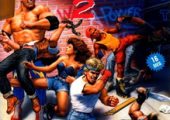
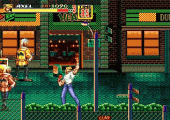
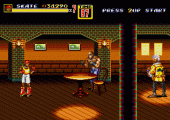
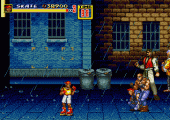
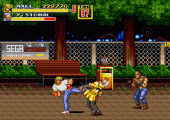
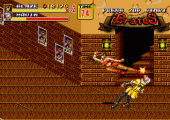
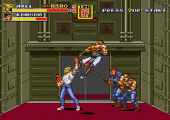
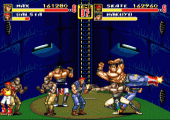
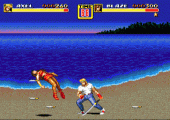
This classic remains on my top games of all time list, and I keep coming up short trying to find a beam ’em up game to top it. Even TMNT games of the era, although fantastic, come up short. I like the FF franchise, but in all areas, it cannot touch this. BKIII is also great, but not as great. I didn’t have this game as a kid, but did play a bunch of it, then finally bought the Sega Smashpack Vol. 1 (1 of 1 hahaha) for the Dreamcast. The sound was pretty awful though, and I’m glad I finally bought a complete copy a few years ago.
Just Awesome!
Here is something for the fans: http://luismartinsartwork.daportfolio.com/gallery/504654#3
Similar games by Capcom and Konami for SNES had better visuals, but when it comes to gameplay and music, this is THE best.
Got nothing to add. Fantastic game I often put on just to hear the music.
What more is there to say really other than the fact that this game is the pinnacle of beat-em-ups? It’s got everything you could want, and then some. I wouldn’t even bother with most of the other games in the genre on the Genesis with this one around.
Streets of Rage 2 (SOR2) did something I took for granted way back in 1992, it perfected the beat em up genre. As a wide eyed kid I remember being delighted every time I played this game and fantasized about how in the future things could only get better. Well 20 years later I can say I was wrong, the genre peaked with this game. SOR2 managed to have perfect game-play, graphics, sound and atmosphere. To this day I haven’t played a more complete game. Using a Baseball analogy this is the “Triple Crown” of 16-Bit gaming. Maybe I should talk about the game?.. Score 10/10
– 4 playable Characters all extremely diverse with a lot of attacks
– 6 Difficulty Settings so anyone one can enjoy
– An enormous soundtrack with most songs being absolute classics
– Gorgeous interesting backgrounds throughout the entire game
– Great graphics and the animations are well done